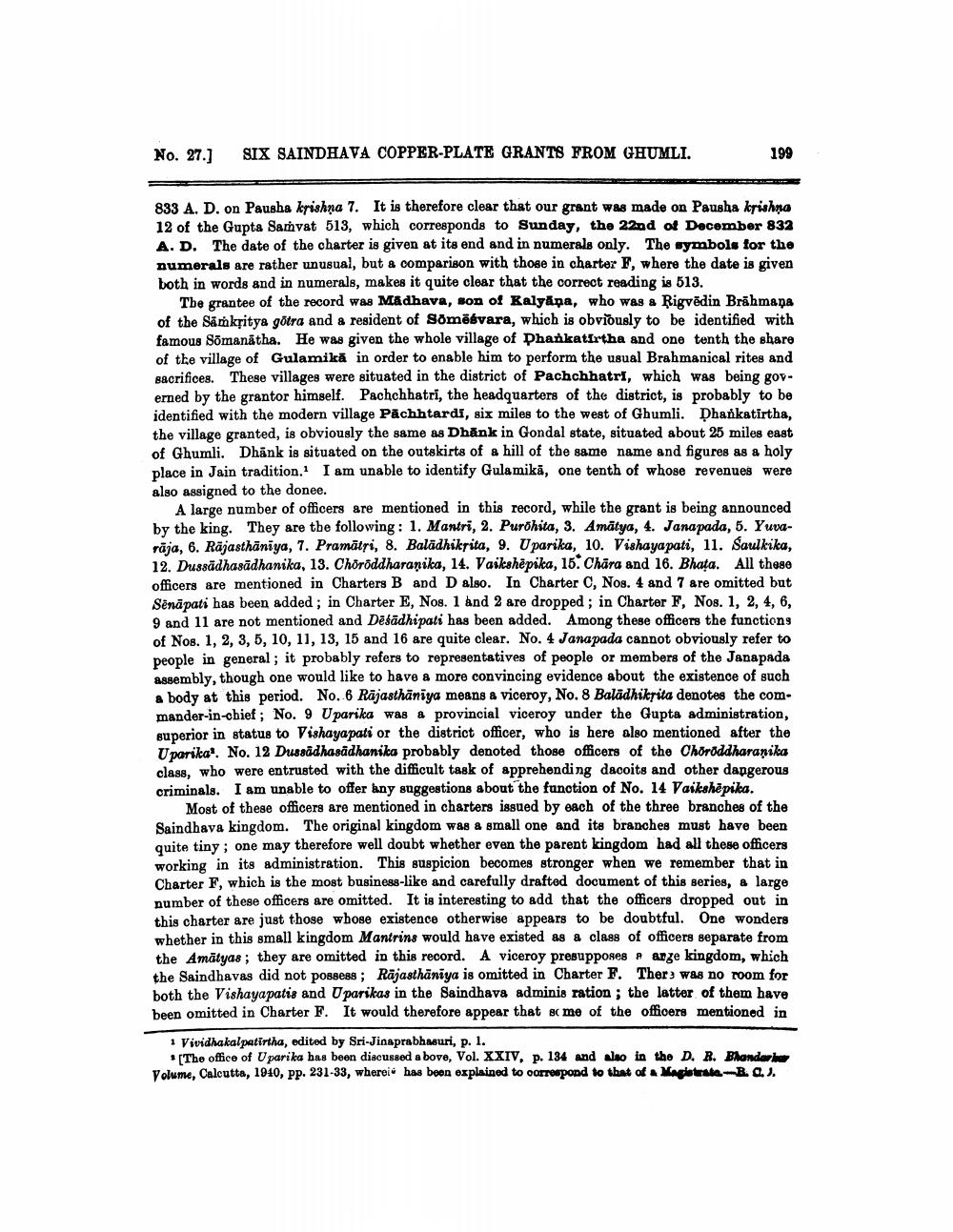________________
No. 27.)
SIX SAINDHAVA COPPER-PLATE GRANTS FROM GHUMLI.
199
833 A. D. on Pausha krishna 7. It is therefore clear that our grant was made on Pausha krishna 12 of the Gupta Samvat 513, which corresponds to Sunday, the 22nd of December 832 A. D. The date of the charter is given at its end and in numerals only. The symbols for the numerals are rather unusual, but a comparison with those in charter F, where the date is given both in words and in numerals, makes it quite clear that the correct reading is 513.
The grantee of the record was Madhava, son of Kalyana, who was a Rigvēdin Brāhmana of the Samkritya götra and a resident of Somēśvara, which is obviously to be identified with famous Sömanåtha. He was given the whole village of Dhankatirtha and one tenth the share of the village of Gulamikā in order to enable him to perform the usual Brahmanical rites and Bacrifices. These villages were situated in the district of Pachchhatri, which was being governed by the grantor himself. Pachchhatri, the headquarters of the district, is probably to be identified with the modern village Pachhtardi, six miles to the west of Ghumli. Dhankatirtha, the village granted, is obviously the same as Dhănk in Gondal state, situated about 25 miles east of Ghumli. Dhänk is situated on the outskirts of a hill of the same name and figures as a holy place in Jain tradition. I am unable to identify Gula mikā, one tenth of whose revenues were also assigned to the donee.
A large number of officers are mentioned in this record, while the grant is being announced by the king. They are the following: 1. Mantri, 2. Purohita, 3. Amatya, 4. Janapada, 5. Yuvarāja, 6. Rajasthaniya, 7. Pramātri, 8. Balādhikrita, 9. U parika, 10. Vishayapati, 11. Saulkika, 12. Dussādhasādhanika, 13. Choroddharanika, 14. Vaikshēpika, 15. Chara and 16. Bhata. All these officers are mentioned in Charters B and D also. In Charter C, Nos. 4 and 7 are omitted but Sēnā pati has been added ; in Charter E, Nos. 1 and 2 are dropped ; in Charter F, Nos. 1, 2, 4, 6, 9 and 11 are not mentioned and Dēsādhipati has been added. Among these officers the functions of Nos. 1, 2, 3, 5, 10, 11, 13, 15 and 16 are quite clear. No. 4 Janapada cannot obviously refer to people in general; it probably refers to representatives of people or members of the Janapada assembly, though one would like to have a more convincing evidence about the existence of such a body at this period. No. 6 Rajasthaniya means a viceroy, No. 8 Balādhikrita denotes the commander-in-chief; No. 9 Uparika was a provincial viceroy under the Gupta administration, superior in status to Vishayapati or the district officer, who is here also mentioned after the U parika!. No. 12 Dussādhasādhanika probably denoted those officers of the Choroddharanika class, who were entrusted with the difficult task of apprehending dacoits and other dangerous criminals. I am unable to offer any suggestions about the function of No. 14 Vaikshēpika.
Most of these officers are mentioned in charters issued by each of the three branches of the Saindhava kingdom. The original kingdom was a small one and its branches must have been quite tiny; one may therefore well doubt whether even the parent kingdom had all these officers working in its administration. This suspicion becomes stronger when we remember that in Charter F, which is the most business-like and carefully drafted document of this series, a large number of these officers are omitted. It is interesting to add that the officers dropped out in this charter are just those whose existence otherwise appears to be doubtful. One wonders whether in this small kingdom Mantrins would have existed as a class of officers separate from the Amātyas ; they are omitted in this record. A viceroy presuppones ange kingdom, which the Saindhavas did not possess ; Rājasthāniya is omitted in Charter F. Ther) was no room for both the Vishayapatis and Uparikas in the Saindhava adminis ration; the latter of them have been omitted in Charter F. It would therefore appear that some of the officers mentioned in
1 Vividhakalpatirtha, edited by Sri-Jinaprabhasuri, p. 1.
*[The office of U parika has been discussed above, Vol. XXIV, p. 184 and also in the D. R. Bhandari Volume, Calcutta, 1940, pp. 231-33, whereiu has been explained to correspond to that of a Magletrata B. a.).




